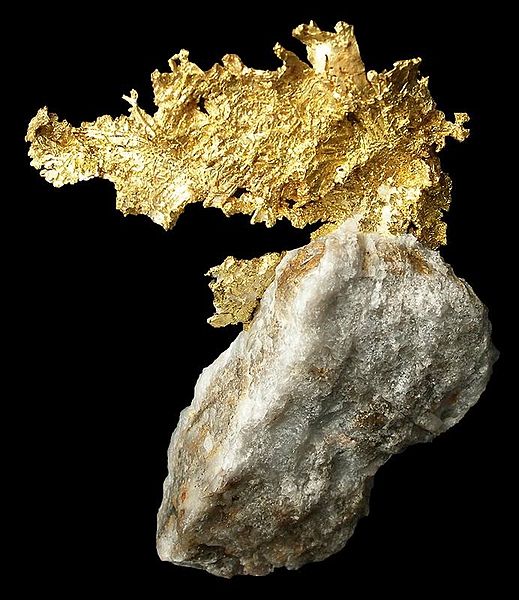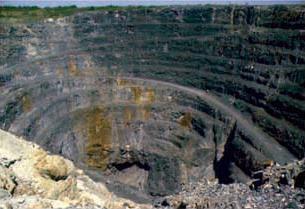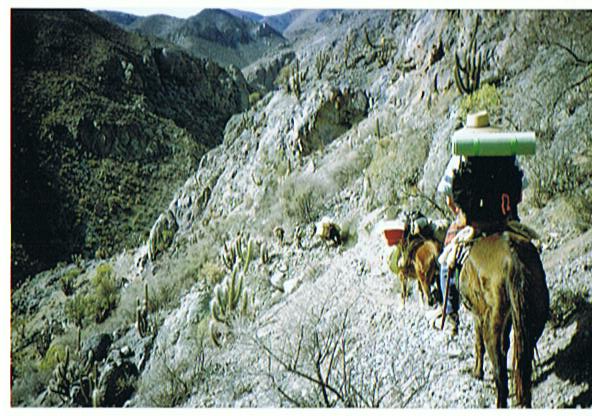Prospecting in hard rock is much different the prospecting in the bed of a stream all though valuable minerals are often found by tracing a trail of specific minerals up a stream until you reach a point where the minerals vanish. When you have reached this point you start looking at the bedrock to see where it had weathered from. Hard rock prospecting is much more complicated than finding placer deposits; it is also much more observational. In this case gold and the other valuable minerals are encased in rock of one sort or another. This enclosing rock is called by the German name “Gangue” a useless rock enclosing the valuable minerals that you are looking for. While quartz is the most common gangue mineral there are plenty of others like calcium carbonate, barite, fluorite and list goes on.
 |
| Gold on Quartz Rob Lavinsky Photo |
In many respects hard rock prospecting is a science of whys, why is that rock discolored, why is that water discolored, why is that vegetation stunted are only a few of the many things prospectors look for in the field. A good prospector will examine every outcrop of rock in the area where he is prospecting looking for signs that it might contain a valuable mineral deposit. The basic tools they uses for finding minerals in the hard rock are a geologists pick, and a magnifying glass usually a loupe having 10X. magnification.
The most common indicator of a valuable mineral because it looks exactly like rust, because it is rust, iron oxide that is called a gossen. Just like many other words used in mining and prospecting is derived from German in this case the word gossen means “iron hat.” This is caused by the weathering of iron bearing minerals usually pyrite, but pyrite often contains other metals in what is called a solid solution series. Because they are so obvious finding a gossen nowadays is virtually impossible.
 |
| Iron Staining (gossen) on the wall of Kidd Creek Mine Timmins, Ontario NOAA |
The most sought after metal and prospecting is gold, and the old saying goes, “Gold is where you find it.” Although it is usually found in quartz veins and stringers throughout any rock that is been affected by hydrothermal activity gold can also be found in many many other types of rocks. The world's largest gold deposits are found in the Witwatersrand in South Africa Witwatersrand come out of fossil remnants of an ancient mountain range.
When he is in the field the prospector is always looking for rocks that are discolored by the action of hot water, rocks that are deformed, faults in the rock that are often the channel for mineral bearing hot water. When he finally finds an area that looks promising the very first thing he does is to collect several grab samples across the width of the presumed mineral deposit for later analysis in a lab. If the results are promising he will go back and chisel a channel right across the vain in several different places. The samples from each vain are kept separate and are also sent to a lab for analysis.
 |
| Prospectors in northern Chile |
Sometimes it is virtually impossible to find any outcrops of rock in this case the prospector has to dig down through the overlaying soil until he reaches bedrock where he may find some viable mineralization by observing some of the indicators that are visible above the soil.
Although hard rock prospecting can be a one-man job more often it is left up to a team of explorers each of whom has his own specialty that is generally led by a geologist or geophysicist. An exploration team like this is capable of finding deposits of gold and other metals in many places that are beyond the capabilities of the single prospector.
 |
| Copper Ore Hannes Grobe |
One of the things the prospector always has to keep in mind is the odds are stacked against them because for every showing of ore only one in about 300 will prove to be viable for constructing a mine. There was a book published in the late 1900s titled, "Gamblers Ruin" a how to book about nine evaluation.although this particular book has been long out of print there are several good books on the subject that are still available with many of them up to date.

Bullion Exchanges is a trusted Bullion Shop located in the heart of New York City's Diamond District.
ReplyDeleteThey have a wide variety of products like, bullion that range from the gold and silver to platinum and palladium.
They are offering an enormous selection of products appealing to first time shoppers and for seasoned collectors.